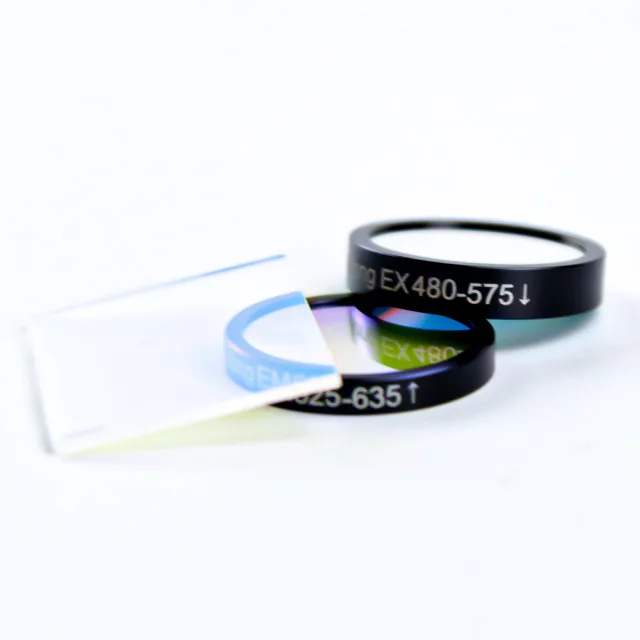The dichroic mirrors play an important role in the mysteries of the microscopic world. One such application is in fluorescence microscopy, where dichroic mirrors serve as key components, enhancing the specificity and clarity of imaging.
In this short article, we’ll describe the functions and purposes of dichroic mirror fluorescence microscopes as well as where to use them.
What is a dichroic mirror fluorescence microscope?
A dichroic mirror, also called a dichroic beamsplitter or dichroic filter, is a specialized optical component that reflects light of one wavelength while allowing light of another wavelength to pass through.
In a fluorescence microscope, the dichroic mirror plays a crucial role in separating the excitation light (used to stimulate fluorescence) from the emitted fluorescence light.
The general function of a dichroic mirror fluorescence microscope?
A dichroic mirror in a fluorescence microscope has many functions. Here we provided some general functions.
Fluorescent Labeling: The example contains fluorophores (fluorescent dyes or proteins) that ingest the mirrored excitation light, ending up being invigorated.
Dichroic Mirror Transmission: The dichroic mirror is made to transmit (allow to pass through) the emitted fluorescence light while efficiently reflecting the excitation light.
Objective Lens Focus: The isolated radiated fluorescence light goes through the objective focal point, which centers it onto the image plane.
Image Formation: The shone fluorescence light makes an image of the example. This image fundamentally addresses the dissemination of the fluorophores inside the specimen.
Image Display: The electronic signal is processed and used to create a visual image on a display device, such as a computer monitor.
Detector Capture: The dichroic mirror directs the emitted fluorescence light towards a detector, such as a camera or photomultiplier tube.
Signal Detection: The detector captures the emitted fluorescence signal, converting it into an electronic signal.

Purpose of dichroic mirror fluorescence microscope?
The dichroic mirror in a fluorescence microscope serves several crucial purposes, all of which contribute to the efficiency and specificity of fluorescence imaging. Here are the key purposes of the dichroic mirror in a fluorescence microscope:
Wavelength Separation
The main purpose of the dichroic mirror is to isolate the excitation light from the discharged fluorescence light given their various wavelengths. The dichroic mirrors the more limited wavelength excitation light towards the example and communicates the more drawn-out wavelength transmitted fluorescence light towards the identifier.
Prevention of Excitation Light in Detection
By mirroring the excitation light away from the finder, the dichroic mirror forestalls undesirable foundation commotion. This is significant for accomplishing a high sign-to-clamor proportion in fluorescence imaging, working on the lucidity and particularity of the noticed fluorescence signal.
Selective Transmission of Fluorescence Emission
The dichroic mirror is intended to productively send the discharged fluorescence light. This particular transmission permits just the fluorescence sign to arrive at the identifier, ensuring that the subsequent image addresses the particular fluorophores present in the specimen.
Enhancement of Contrast and Specificity
The dichroic mirror upgrades the differentiation and particularity of the fluorescence signal by guaranteeing that the pertinent produced fluorescence light adds to the last image. This is especially significant in complex natural examples where explicit designs should be imagined amid foundation fluorescence.
Optical Efficiency
The dichroic mirror is intended to be profoundly productive in reflecting and sending explicit wavelengths. This optical proficiency adds to the general exhibition of the fluorescence microscope.
Where is the use of dichroic mirror fluorescence microscopes?
Dichroic mirror fluorescence microscopes are used in various important fields for studying biological specimens and materials. Here are some important places where these microscopes find applications.
Biomedical Research Laboratories
Fluorescence microscopes with dichroic mirrors are highly used in biomedical research labs. For example, to study cellular structures, proteins, and dynamic processes in living organisms.
Hospitals and Pathology Departments
In clinical settings, fluorescence microscopy is employed for diagnostic purposes. Even particularly in pathology departments for examining tissue samples as well as detecting specific markers associated with diseases.
Pharmaceutical Research and Drug Discovery
The fluorescence microscopes are also used to study the effects of drugs on cells and tissues, aiding in drug discovery and development in pharmaceutical research.
Cancer Research Centers
Cancer researchers use fluorescence microscopy to study cancer cells, visualize specific biomarkers, and understand the mechanisms of tumorigenesis.
Neuroscience Laboratories
Neuroscience laboratories utilize it to investigate the structure and function of neurons, synapses, and other components of the nervous system.
Genetics and Molecular Biology Facilities
Laboratories focused on genetics and molecular biology use fluorescence microscopy for applications. Such as visualizing gene expression patterns and studying DNA structures.
Without these fields, Dichroic mirror fluorescence microscopes are used in more places.
Conclusion
Thanks for reading the article and hopefully it will be helpful in many ways in your research and study. If you have to know more you can visit our web site.
